
They are the unconventional ‘patients’ that can weigh more than 500kg and pose a risk to both themselves and paramedics.
But the dangers associated with rescuing horses, cows and sheep are set to be mitigated after our six Ambulance Rescue units undertook specific training to treat large domestic animals.
The units – based in Rutherford, Singleton, Tamworth, Cowra, Bomaderry and Wagga Wagga – are required to undergo animal rescue training as part of their General Land Rescue accreditation, but last month marked the first time specialised training was carried out for large domestic animals.
On the back of a growing trend whereby large animals are getting themselves into “sticky situations”, Special Operations Coordinator Rescue Paramedic Dane Goodwin saw a need to implement specific large animal training.
He engaged the services of Hawkesbury State Emergency Service volunteer Dave King, an animal rescue expert, who held day-long seminars with each unit last month.
“The training has been invaluable,” Dane said.
“Horses, for example, can inflict an awful amount of injury if the techniques are not done right.
“So it’s beneficial for the safety of the rescuers and those large domestic animals.
“We will increasingly get tasked to do these jobs, so to have the training and the right equipment is absolutely a must to keep everyone safe.”
The seminars began with a theoretical component before being followed by a practical component, which included paramedics conducting a mock animal rescue using a 300kg plastic horse.
He said rescue techniques taught to paramedics included “sliding, slinging and lifting”.
Hunter Zone 2 Duty Operations Manager Joel de’Zuna, who attended the training event at Rutherford Station, said this training was “very beneficial” to paramedics who took part on the day.
“I think this training will be very important leading into the future,” he said.
“A lot of our rescue paramedics have never rescued large animals before. “The areas that our rescue units work have a lot of equine assets.
“Not only that, there are cows and sheep that certainly get transported in those areas which we could possibly get called out for if there is a road transport incident involving those animals.”
